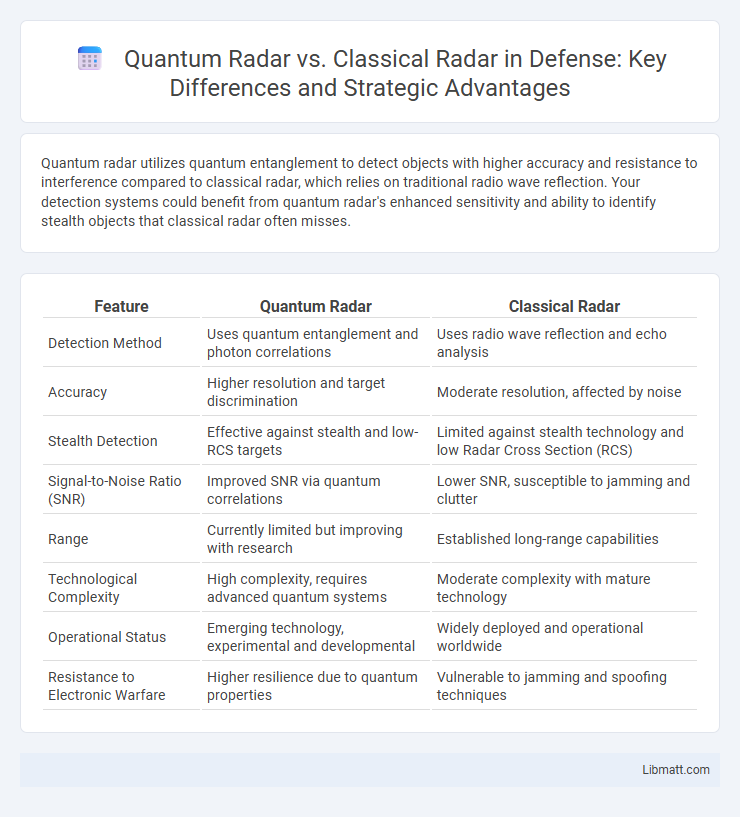Quantum radar utilizes quantum entanglement to detect objects with higher accuracy and resistance to interference compared to classical radar, which relies on traditional radio wave reflection. Your detection systems could benefit from quantum radar's enhanced sensitivity and ability to identify stealth objects that classical radar often misses.
Table of Comparison
| Feature | Quantum Radar | Classical Radar |
|---|---|---|
| Detection Method | Uses quantum entanglement and photon correlations | Uses radio wave reflection and echo analysis |
| Accuracy | Higher resolution and target discrimination | Moderate resolution, affected by noise |
| Stealth Detection | Effective against stealth and low-RCS targets | Limited against stealth technology and low Radar Cross Section (RCS) |
| Signal-to-Noise Ratio (SNR) | Improved SNR via quantum correlations | Lower SNR, susceptible to jamming and clutter |
| Range | Currently limited but improving with research | Established long-range capabilities |
| Technological Complexity | High complexity, requires advanced quantum systems | Moderate complexity with mature technology |
| Operational Status | Emerging technology, experimental and developmental | Widely deployed and operational worldwide |
| Resistance to Electronic Warfare | Higher resilience due to quantum properties | Vulnerable to jamming and spoofing techniques |
Introduction to Quantum and Classical Radar
Quantum radar utilizes entangled photons to detect objects with higher resolution and better resistance to jamming compared to classical radar, which relies on radio waves to emit pulses and analyze echoes for object detection. Classical radar systems dominate current applications due to established technology and cost-efficiency, while quantum radar remains experimental with potential advantages in stealth detection and precision targeting. Your choice between these technologies depends on the need for enhanced sensitivity, detection capability, and operational environment.
Fundamental Principles of Radar Technologies
Quantum radar leverages quantum entanglement and photon correlation to detect objects with higher sensitivity and enhanced resolution, enabling the detection of stealth targets that classical radar might miss. Classical radar operates by emitting radio waves and analyzing their reflections from objects, relying on signal strength and timing to determine location and velocity. The fundamental difference lies in quantum radar's utilization of quantum states, which reduces noise and improves detection accuracy compared to the electromagnetic wave-based approach of classical systems.
How Classical Radar Works
Classical radar operates by emitting radio waves that bounce off objects and return to the receiver, allowing the system to determine the distance, speed, and location of targets based on the time delay and Doppler shift of the reflected signals. This conventional method relies on signal processing techniques to filter noise and enhance target detection in complex environments. Your ability to track objects depends on the radar's power, frequency, and resolution, which define its effectiveness in diverse conditions.
Quantum Radar: Technology and Mechanisms
Quantum radar utilizes entangled photons and quantum superposition to detect objects with enhanced resolution and stealth capabilities unlike classical radar. This technology exploits quantum entanglement to improve detection sensitivity, allowing it to identify objects masked by noise or cloaking techniques that typically challenge classical radar systems. Your ability to detect low-reflectivity or stealth targets is significantly improved, leveraging the quantum correlation between transmitted and received signals.
Key Differences between Quantum and Classical Radar
Quantum radar utilizes entangled photons to detect objects with higher resolution and improved resistance to jamming compared to classical radar, which relies on electromagnetic wave reflection. Quantum radar can detect stealth objects and operate effectively in noisy environments due to quantum correlations, while classical radar struggles with low radar cross-section targets and signal interference. Your ability to detect and track targets improves significantly with quantum radar's enhanced sensitivity and accuracy.
Performance Comparison: Range, Resolution, and Accuracy
Quantum radar leverages quantum entanglement to potentially detect objects with higher resolution and improved accuracy over classical radar, especially in challenging environments with low signal-to-noise ratios. While classical radar typically offers longer range due to mature technology and signal strength, quantum radar can outperform in resolution by distinguishing target details beyond classical diffraction limits. Your choice between these technologies depends on specific application needs, balancing classical radar's established range capabilities against quantum radar's promising accuracy and finer spatial resolution.
Applications in Defense and Civil Sectors
Quantum radar offers enhanced detection capabilities by leveraging quantum entanglement, significantly improving target identification and stealth object detection in defense applications. Classical radar remains widely utilized for air traffic control and weather monitoring due to its established reliability and extensive infrastructure. Your choice between quantum and classical radar technologies depends on the specific requirements for sensitivity, range, and environmental conditions in defense or civil sectors.
Challenges and Limitations of Quantum Radar
Quantum radar faces significant challenges including limited range and sensitivity due to current quantum technology constraints, which prevent it from outperforming classical radar in practical scenarios. The complexity of maintaining quantum entanglement over long distances and the high cost of quantum hardware also limit its widespread adoption. Your ability to benefit from quantum radar depends heavily on advancements in quantum error correction and noise reduction techniques.
Future Prospects of Quantum Radar Technology
Quantum radar technology promises significant advancements over classical radar by utilizing quantum entanglement to detect objects with higher precision and reduced susceptibility to noise and jamming. Future prospects include enhanced target detection in cluttered environments, improved stealth object identification, and increased resilience against electronic countermeasures. Ongoing research aims to overcome current challenges such as system complexity and range limitations, potentially enabling widespread adoption in defense and surveillance applications.
Conclusion: The Evolving Landscape of Radar Systems
Quantum radar offers enhanced detection capabilities by exploiting quantum entanglement to improve target resolution and reduce interference, surpassing the limitations of classical radar. Classical radar systems remain widely used due to their proven reliability, cost-effectiveness, and established infrastructure. As quantum technology matures, the integration of quantum radar components is expected to revolutionize surveillance and defense, signaling a transformative shift in radar system capabilities and application scope.
quantum radar vs classical radar Infographic

 libmatt.com
libmatt.com